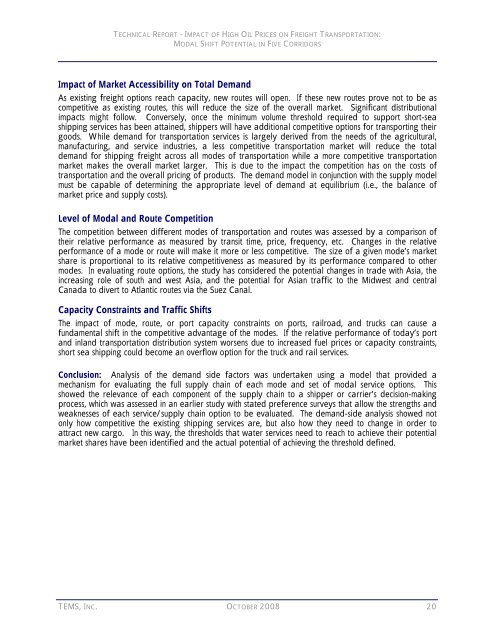impact of high oil prices on freight transportation: modal shift ...
impact of high oil prices on freight transportation: modal shift ...
impact of high oil prices on freight transportation: modal shift ...
You also want an ePaper? Increase the reach of your titles
YUMPU automatically turns print PDFs into web optimized ePapers that Google loves.
TECHNICAL REPORT - IMPACT OF HIGH OIL PRICES ON FREIGHT TRANSPORTATION:<br />
MODAL SHIFT POTENTIAL IN FIVE CORRIDORS<br />
Impact <str<strong>on</strong>g>of</str<strong>on</strong>g> Market Accessibility <strong>on</strong> Total Demand<br />
As existing <strong>freight</strong> opti<strong>on</strong>s reach capacity, new routes will open. If these new routes prove not to be as<br />
competitive as existing routes, this will reduce the size <str<strong>on</strong>g>of</str<strong>on</strong>g> the overall market. Significant distributi<strong>on</strong>al<br />
<str<strong>on</strong>g>impact</str<strong>on</strong>g>s might follow. C<strong>on</strong>versely, <strong>on</strong>ce the minimum volume threshold required to support short-sea<br />
shipping services has been attained, shippers will have additi<strong>on</strong>al competitive opti<strong>on</strong>s for transporting their<br />
goods. While demand for transportati<strong>on</strong> services is largely derived from the needs <str<strong>on</strong>g>of</str<strong>on</strong>g> the agricultural,<br />
manufacturing, and service industries, a less competitive transportati<strong>on</strong> market will reduce the total<br />
demand for shipping <strong>freight</strong> across all modes <str<strong>on</strong>g>of</str<strong>on</strong>g> transportati<strong>on</strong> while a more competitive transportati<strong>on</strong><br />
market makes the overall market larger. This is due to the <str<strong>on</strong>g>impact</str<strong>on</strong>g> the competiti<strong>on</strong> has <strong>on</strong> the costs <str<strong>on</strong>g>of</str<strong>on</strong>g><br />
transportati<strong>on</strong> and the overall pricing <str<strong>on</strong>g>of</str<strong>on</strong>g> products. The demand model in c<strong>on</strong>juncti<strong>on</strong> with the supply model<br />
must be capable <str<strong>on</strong>g>of</str<strong>on</strong>g> determining the appropriate level <str<strong>on</strong>g>of</str<strong>on</strong>g> demand at equilibrium (i.e., the balance <str<strong>on</strong>g>of</str<strong>on</strong>g><br />
market price and supply costs).<br />
Level <str<strong>on</strong>g>of</str<strong>on</strong>g> Modal and Route Competiti<strong>on</strong><br />
The competiti<strong>on</strong> between different modes <str<strong>on</strong>g>of</str<strong>on</strong>g> transportati<strong>on</strong> and routes was assessed by a comparis<strong>on</strong> <str<strong>on</strong>g>of</str<strong>on</strong>g><br />
their relative performance as measured by transit time, price, frequency, etc. Changes in the relative<br />
performance <str<strong>on</strong>g>of</str<strong>on</strong>g> a mode or route will make it more or less competitive. The size <str<strong>on</strong>g>of</str<strong>on</strong>g> a given mode’s market<br />
share is proporti<strong>on</strong>al to its relative competitiveness as measured by its performance compared to other<br />
modes. In evaluating route opti<strong>on</strong>s, the study has c<strong>on</strong>sidered the potential changes in trade with Asia, the<br />
increasing role <str<strong>on</strong>g>of</str<strong>on</strong>g> south and west Asia, and the potential for Asian traffic to the Midwest and central<br />
Canada to divert to Atlantic routes via the Suez Canal.<br />
Capacity C<strong>on</strong>straints and Traffic Shifts<br />
The <str<strong>on</strong>g>impact</str<strong>on</strong>g> <str<strong>on</strong>g>of</str<strong>on</strong>g> mode, route, or port capacity c<strong>on</strong>straints <strong>on</strong> ports, railroad, and trucks can cause a<br />
fundamental <strong>shift</strong> in the competitive advantage <str<strong>on</strong>g>of</str<strong>on</strong>g> the modes. If the relative performance <str<strong>on</strong>g>of</str<strong>on</strong>g> today’s port<br />
and inland transportati<strong>on</strong> distributi<strong>on</strong> system worsens due to increased fuel <str<strong>on</strong>g>prices</str<strong>on</strong>g> or capacity c<strong>on</strong>straints,<br />
short sea shipping could become an overflow opti<strong>on</strong> for the truck and rail services.<br />
C<strong>on</strong>clusi<strong>on</strong>: Analysis <str<strong>on</strong>g>of</str<strong>on</strong>g> the demand side factors was undertaken using a model that provided a<br />
mechanism for evaluating the full supply chain <str<strong>on</strong>g>of</str<strong>on</strong>g> each mode and set <str<strong>on</strong>g>of</str<strong>on</strong>g> <strong>modal</strong> service opti<strong>on</strong>s. This<br />
showed the relevance <str<strong>on</strong>g>of</str<strong>on</strong>g> each comp<strong>on</strong>ent <str<strong>on</strong>g>of</str<strong>on</strong>g> the supply chain to a shipper or carrier’s decisi<strong>on</strong>-making<br />
process, which was assessed in an earlier study with stated preference surveys that allow the strengths and<br />
weaknesses <str<strong>on</strong>g>of</str<strong>on</strong>g> each service/supply chain opti<strong>on</strong> to be evaluated. The demand-side analysis showed not<br />
<strong>on</strong>ly how competitive the existing shipping services are, but also how they need to change in order to<br />
attract new cargo. In this way, the thresholds that water services need to reach to achieve their potential<br />
market shares have been identified and the actual potential <str<strong>on</strong>g>of</str<strong>on</strong>g> achieving the threshold defined.<br />
TEMS, INC. OCTOBER 2008<br />
20

















